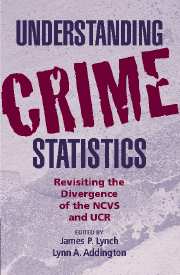Book contents
1 - Introduction
Published online by Cambridge University Press: 23 December 2009
Summary
For the past 30 years, the Uniform Crime Reporting System (UCR) and the National Crime Victimization Survey (NCVS), which includes its predecessor the National Crime Survey (NCS), have been the two sources of national level estimates of crime in the United States as well as estimates of changes in crime rates. During most of this time, the two series have presented a consistent picture of crime trends. Episodically, however, the two series diverge. Initially this divergence produced ill-informed debates about which series was the better indicator of crime, built around the assumption that only one data source could be correct. These debates motivated researchers to examine the issue of divergence (see Chapter 4, this volume, for a summary). One of the most significant works arising from this body of work is the 1991 book Understanding Crime Incidence Statistics: Why the UCR Diverges from the NCS written by Albert Biderman and one of the coeditors of the current volume, James Lynch. Biderman and Lynch's work used the divergence of the UCR–NCS trends as a vehicle for explaining how each data series measures crime differently and for emphasizing that it was acceptable (and even expected) for the two data series to diverge. Their work had two important results. First, it helped quell the “which is better” debates. Second, their work established a foundation for today's commonly held perception that the two indicators are complementary as opposed to competing and that each system should enlighten the portion of the crime problem it is best equipped to address.
- Type
- Chapter
- Information
- Understanding Crime StatisticsRevisiting the Divergence of the NCVS and the UCR, pp. 3 - 14Publisher: Cambridge University PressPrint publication year: 2006

